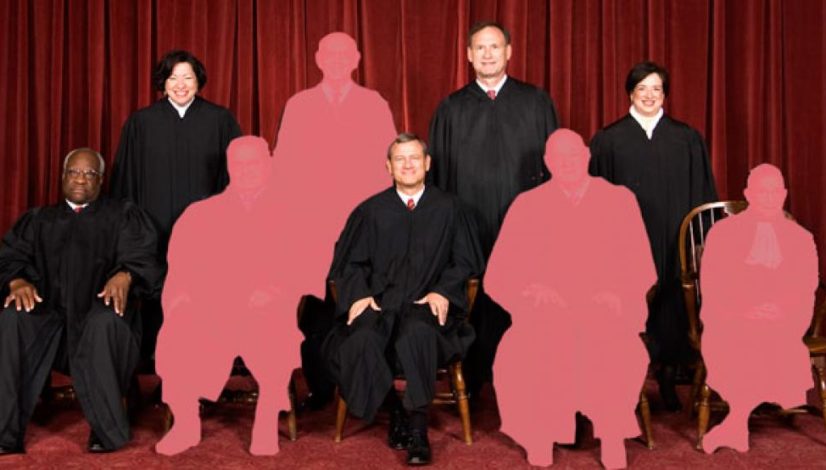The Long-term Menace of a Hillary Win: Decades of a Liberal Supreme Court
Any day now the Supreme Court will rule on President Obama’s go-it-alone executive action protecting millions of undocumented persons against deportation. However it comes down, the decision will again inflame this bitterly divided nation; it will also remind moody Republicans why they must absolutely vote for Donald Trump.
Heads-up to Republicans queasy about Trump: there is no question – none at all – that Hillary Clinton’s picks to fill the seat of deceased Supreme Court Justice Antonin Scalia and other judges who may shortly retire would embed and extend President Obama’s progressive agenda for decades to come. If voters don’t like Obama’s single-handed upending of our immigration laws, his push towards Big Labor, or if they disagree with his purposeful extermination of U.S. fossil fuels industries, Donald Trump is their only choice.
Justice Ruth Ginsberg is 83 years old, Anthony Kennedy is two months away from turning 80, Clarence Thomas is nearly 68 and Stephen Breyer is 77. All could retire in the next four to eight years. Including Scalia, 3 right-leaning or conservative justices are likely to leave the court; were Hillary Clinton to nominate their replacements, there would be a 7-2 leftist majority on the court. Only Samuel Alito (age 66) and Chief Justice John Roberts (61) would tilt right. If Clinton picks candidates in their fifties, we’re talking decades of liberalism spilling from the bench.
Over the past seven years, the Supreme Court has proved critical in confining an overreaching president. A Republican majority in the House and Senate has barely slowed President Obama’s legacy quest. Nor has the unpopularity of many of his priorities. Twice – in 2010 and 2014 — Obama was rebuked at the voting booth, in historic numbers. It deterred him not a whit.
The only brake on his go-it-alone presidency has been the Supreme Court. When Obama used a faux senate recess in 2012 to appoint three liberal commissioners to the National Labor Relations Board, the Court unanimously ruled (two years later) that he had violated the Constitution. This was a serious slap on the wrist, but also a speed bump, preventing that board from rapidly tilting our labor laws in the direction of France – that is, making our country all but uncompetitive.
Shifting the Balance of Power
As important as its impact on labor rulings, the court’s decision in National Labor Relations Board v. Noel Canning set limits on Obama’s ability to make recess appointments. When the GOP took control of the Senate in 2012, at which time the president could no longer count on easy confirmation for his nominees, that decision became significant. It became especially important after the death of Justice Antonin Scalia, which occurred during a Senate recess. Many speculate that President Obama held back from trying to immediately shove through a replacement on the bench because of the Noel Canning decision.
The Supreme Court has disappointed conservatives in some high profile cases, such as when it saved Obamacare in 2012 by deciding that the individual mandate was a tax, and therefore fell within Congress’ jurisdiction. However, in that decision the court also reined in Washington’s regulation of interstate commerce and cheered conservatives by limiting how the federal government can use withheld funds to impose demands on states. Specifically, the justices voted 7-2 to reject the government’s attempt to coerce states into expanding Medicaid by taking away all Medicaid funding if they refused.
There have been numerous lower-profile decisions during the Obama reign that have curbed White House excess. Some have buttressed the first amendment’s guarantee of freedom of religion. In 2012, the Supremes ruled that churches – and not the Obama White House — have the right to decide who counts as clergy. In 2014, the Court ruled 5-4 in Burwell v. Hobby Lobby that for closely-held for-profit corporations, the Obamacare contraception mandate violated the Religious Freedom Restoration Act. That ruling would have gone the other way in a Clinton-packed court.
The court has also ruled against the Obama administration in cases upholding the right of free speech, backing the rights of landowners and protecting against unreasonable search and seizure.
All these decisions helped slow the Obama juggernaut. None, however, is as important as the 5-4 stay granted earlier this year that prevented implementation of the Environmental Protection Agency’s Clean Power Plan. The CPP is viewed as Obama’s signature environmental effort; it is essential to meeting the emissions targets incorporated in the president’s much-ballyhooed international climate accord. Conservatives consider the plan a vast overreach of executive authority since it impacts the entire power industry and had already required some $10 billion per year in compliance spending.
Note that the stay simply means that challenges to the CPP will be heard by the U.S. Court of Appeals for the D.C. Circuit, which will likely hand down a ruling in the fall. There is a good chance the Supreme Court will again be asked to rule on the matter.
But it is a decision on the legality of President Obama’s executive order protecting millions from deportation that looms over the upcoming election. Obama’s 2014 Deferred Action for Parents of Americans and Lawful Permanent Residents and his expansion of the 2012 Deferred Action for Childhood Arrivals are being challenged by 26 states and by Republicans in Congress as an overreach of executive authority. If the president gets his way, it would be an alarming realignment of the powers of the executive branch versus Congress.
Going forward, the court will influence how the country manages immigration, labor laws, gun ownership, religious freedom, environmental action and much, much more. Electing Hillary Clinton will not shift U.S. policy for four or eight years; it will determine the path we will follow for a generation. Trump is unsettling and erratic, but it is far less likely that he would have a commensurate impact on the nation’s fortunes.
Published here.




